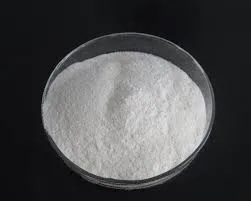
Dec . 18, 2024 01:20 Back to list
hpmc synthesis
The Synthesis of HPMC A Comprehensive Overview
Hydroxypropyl methylcellulose (HPMC) is a widely used polymer known for its versatility in various applications, including pharmaceuticals, food, cosmetics, and construction. As a cellulose derivative, HPMC is synthesized through a multi-step process that involves the modification of cellulose to enhance its properties. This article aims to provide an in-depth understanding of the synthesis of HPMC, the methods involved, and its significance in various industries.
Understanding HPMC
HPMC is a semi-synthetic polymer derived from natural cellulose, which is obtained from plant fibers. The primary features of HPMC include its high water solubility, excellent film-forming abilities, and the capability to form stable emulsions. These unique characteristics stem from the introduction of hydroxypropyl and methyl groups to cellulose, which alters its solubility behavior and thermal stability.
Synthesis Process
The synthesis of HPMC typically involves four main steps cellulose extraction, methylation, hydroxypropylation, and purification.
1. Cellulose Extraction The first step in HPMC synthesis is the extraction of cellulose from natural sources such as wood pulp or cotton linter. This extraction process generally involves the treatment of raw plant materials with chemicals to remove non-cellulosic components like lignin and hemicellulose.
2. Methylation Once cellulose is extracted, the next step is methylation, where methyl groups are introduced to the cellulose molecule. This is usually done by reacting cellulose with methyl chloride in the presence of a base, such as sodium hydroxide. The methylation process modifies the cellulose structure, enhancing its solubility in water and improving its viscosity characteristics.
hpmc synthesis

3. Hydroxypropylation Following methylation, hydroxypropylation is performed to introduce hydroxypropyl groups into the cellulose structure. This is achieved by treating the methylated cellulose with propylene oxide. The hydroxypropyl groups further improve the solubility and thermal stability of HPMC, making it an even more effective polymer for various applications.
4. Purification The final step of the synthesis involves the purification of HPMC to remove any unreacted chemicals and by-products from the methylation and hydroxypropylation reactions. This often includes washing the product with water and drying it to obtain a pure, white powder form of HPMC.
Applications of HPMC
Due to its unique properties, HPMC finds applications in a variety of fields. In the pharmaceutical industry, it is commonly used as a binder, thickener, and excipient in the formulation of tablets and capsules. Its ability to control release rates makes it invaluable in controlled-release drug delivery systems.
In the food industry, HPMC serves as a food additive, providing texture and stability in various products, such as sauces, ice creams, and baked goods. Its emulsifying properties help maintain consistency and enhance mouthfeel.
In the construction sector, HPMC is incorporated into adhesives and mortar products. It acts as a water-retention agent, which is critical for improving the workability of cement and gypsum-based materials. Additionally, its film-forming capability contributes to the durability of coatings and sealants.
Conclusion
The synthesis of HPMC is a remarkable example of how natural polymers can be modified to suit specific industrial needs. Through the processes of methylation and hydroxypropylation, cellulose is transformed into a versatile material with applications spanning pharmaceuticals, food, and construction. As industries continue to evolve, the relevance of HPMC will likely grow, driven by the increasing demand for sustainable and effective materials. The ongoing research and development in this field promise to unlock new possibilities and enhance the characteristics of HPMC, further solidifying its place in the modern economy.
-
Versatile Hpmc Uses in Different Industries
NewsJun.19,2025
-
Redispersible Powder's Role in Enhancing Durability of Construction Products
NewsJun.19,2025
-
Hydroxyethyl Cellulose Applications Driving Green Industrial Processes
NewsJun.19,2025
-
Exploring Different Redispersible Polymer Powder
NewsJun.19,2025
-
Choosing the Right Mortar Bonding Agent
NewsJun.19,2025
-
Applications and Significance of China Hpmc in Modern Industries
NewsJun.19,2025







